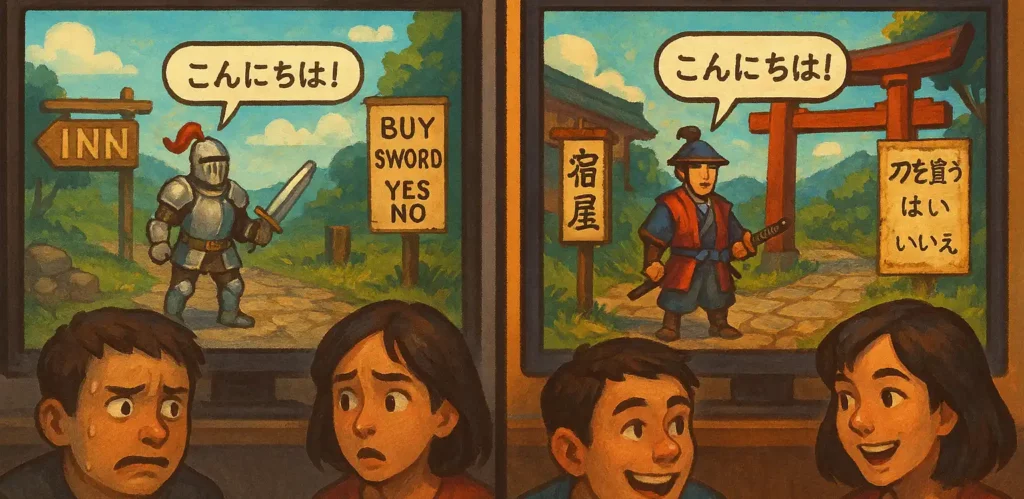Translating for the gaming industry isn’t just about converting text—it’s about crafting experiences. As someone who’s spent time both playing games and working with translation professionals, I’ve seen firsthand how language can make or break immersion.
Game localization requires far more than linguistic skill: it demands cultural sensitivity, user experience insight, and technical fluency.
Unlike static content like websites or manuals, game translation is alive. It’s shaped by storylines, voice-overs, character dialogue, interactive menus, real-time action, and emotional arcs. If you’ve ever paused mid-game to laugh at a pun or gasp at a plot twist, imagine trying to re-create that moment for a completely different audience. That’s the beauty—and challenge—of game localization.
Read on to explore why translating games is one of the most dynamic, creative, and complex corners of the language industry.
1. The Complexity of Game Content and Context
Video games combine visual, audio, narrative, and interactive elements. This multimedia fusion creates a rich, immersive experience that must be preserved across different languages and cultures. However, the complexity of game genres, interfaces, character personalities, and player choices often creates significant translation challenges.
Translators must understand the gameplay to contextualize dialogue and terminology. For example, a weapon’s name may sound epic in one language but lose its impact when directly translated. In RPGs (Role-Playing Games), a character’s personality and speech patterns define their role in the story. Missing such nuances can break player immersion.

In total, translators often need to play the game—or at least observe detailed gameplay—before beginning translation. Without proper context, it’s easy to misinterpret phrases that hold specific in-game meaning.
Game companies may provide glossaries or style guides, but these are rarely comprehensive. In fast-paced development cycles, crucial context may not be available until late in the process.
As a general rule, games demand transcreation—a creative blend of translation and cultural adaptation.
2. Cultural Nuances and Localization Pitfalls
Culture is central to game design and storytelling. A joke that resonates in Japan might fall flat—or cause confusion—in Germany. A reference to local customs or historical events could alienate or even offend international players.
Localization means adapting game content to align with the cultural expectations of a target market. This includes adjusting idioms, humor, character names, design elements, and sometimes even plot points. For example, games released in China often require significant changes to violent or supernatural content to comply with censorship regulations.
On average, localization accounts for over 30% of a game’s global development budget—especially for AAA titles. It’s not just about language; it’s about creating a seamless player experience.
A well-known case is Nintendo’s “Fire Emblem Fates,” where the Western localization team made significant changes to controversial scenes from the Japanese version. These edits sparked debates about over-localization and authenticity in global gaming communities.

Well-localized game should feel like it was originally developed for the local market—not just translated from English, Japanese, or another source language.
READ MORE:How We Completed a Mobile Game Translation in Chinese in 10 Working Days
3. Technical Constraints and UI Translation Challenges
Games come with strict technical limitations, particularly when it comes to user interfaces (UI), menus, and heads-up displays (HUDs). A phrase that fits neatly in English may not fit in longer languages like German or Russian.
Translators must often condense or rephrase text to fit space constraints without losing meaning or clarity. This balance between brevity and accuracy is a unique skill.

Additionally, text in games is frequently embedded in code. One misplaced character or formatting error could crash the game or break a feature. Therefore, translators often use specialized localization software or XML editors to prevent errors.
Font sizes, button layouts, and dialogue boxes may also require redesigning to accommodate translated text. Effective collaboration between developers and translators is essential to maintain usability.
In mobile games, where screen real estate is particularly limited, these challenges are even more pronounced. As a general rule, mobile game translations require extra brevity and UI adaptability.
4. Voice-Over and Subtitle Synchronization
Voice-over localization adds another level of complexity. Translators must create scripts that match the timing, emotional tone, and (in some cases) lip-sync of the original dialogue.
This is especially demanding in story-driven games where emotional delivery is crucial. A poorly translated or out-of-sync voice line can ruin an otherwise powerful scene.
On average, recording and syncing voice-overs across multiple languages can take several months. It requires close collaboration between translators, voice actors, directors, and audio engineers.
Subtitling brings its own set of constraints. Subtitles must be timed precisely, be easy to read, and convey the tone of the original script. Long subtitles can overwhelm players and detract from gameplay.
In total, this aspect of game localization can involve hundreds of professionals working across different time zones and cultures.
5. Live Games, Ongoing Updates, and Community Feedback
Many modern games operate as live services—continuously updated with new content, features, events, and balance patches. This makes localization an ongoing responsibility rather than a one-time project.
New game content must be translated and released quickly to maintain global consistency. Delays of even a few days can frustrate players or damage trust in the brand.
Player communities are also highly engaged and vocal. Translation mistakes are often shared publicly on social media, forums, and review sites. While this feedback can be valuable, it can also escalate into negative publicity.

One example is “Genshin Impact,” which faced criticism in multiple regions for inconsistent translation and voice-over mismatches during early updates. In response, the developer increased its regional translation staff and opened communication channels with players.
As a whole, live service games demand a localization team that is agile, responsive, and deeply integrated with the game’s development pipeline.
Why Specialized Game Translators Matter
Game translation is a unique blend of art, science, and passion. It requires not only linguistic expertise but also cultural sensitivity, technical know-how, and a love of gaming.

With the global gaming market projected to exceed $250 billion by 2025, quality localization is no longer optional—it’s essential for success.
Studios that invest in skilled game translators gain access to wider markets, stronger brand loyalty, and more satisfied players. Conversely, poor localization can result in ridicule, negative reviews, and even regulatory challenges.
In summary, translating for the gaming industry is a complex yet highly rewarding discipline. When executed effectively, game localization brings immersive worlds to life for millions of players worldwide—and helps studios unlock their true global potential.
READ MORE:How We Completed a Mobile Game Translation in Chinese in 10 Working Days
